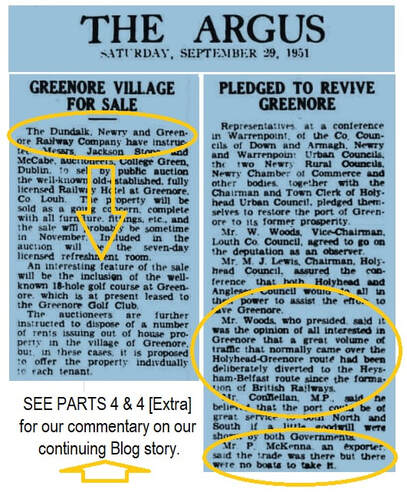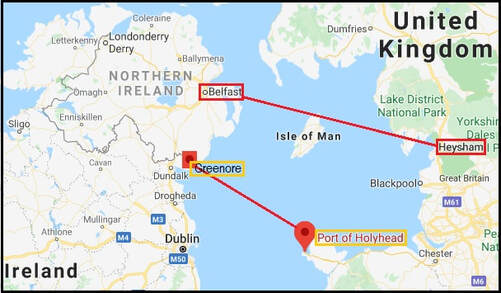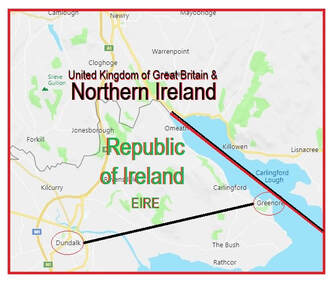|
Prince Charles explains 'pebble theatre'.
|
PEBBLE
|
|
Don Pierson [right] explains how a young Prince Charles made a request to join the Radio London fan club. |
|
|
Prince Charles explains 'pebble theatre'.
|
PEBBLE
|
|
Don Pierson [right] explains how a young Prince Charles made a request to join the Radio London fan club. |
|
 The story (shown right), reflects the actual situation at Greenore on September 29, 1951. The Seller was the Dundalk, Newry and Greenore Company, which came under the ownership of LMS which was represented in the Republic of Ireland by Great Northern Railway (Ireland) company, (GNRI). When the British half of these railway interests were nationalized in 1947 and then brought under the banner of British Railways (BR), the British half of this contract pulled out of the agreement which included the Dundalk Locomotive Works. So while the Dundalk Locomotive Works immediately became an industrial and political problem that resulted in the stop-gap creation of the Great Northern Railway Board (GNRB) which was jointly owned by both the Irish and British governments, the Greenore property was simply dumped on to the open market. The GNRB had its hands full of problems at Dundalk with all of the about-to-be employees deprived of a job with income, and GNRB's attempt to resolve their immediate situation was not very successful. But Greenore was now a property deprived of any population, save for the few who lived in houses adjacent to the golf course; hotel and railway station which were all a part of one property that had been turned over to Messrs. Jackson Stops and McCabe; a Dublin firm of auctioneers.  Although there was no population left in Greenore to really cause problems, unlike Dundalk, the local Irish government officials did engage in a blame game. (See the news story above.) Clearly no one was going to worry about the houses; golf course and railway station, but the ferry service was another matter. But again, we need to recall that back in 1940 the passenger service was terminated and all that was left was a once-a-week freight (cargo) service going by sea from Greenore in the Republic of Ireland to Holyhead in the United Kingdom which originated from the island of Great Britain, and not from Ireland. That once-a-week ship which had sailed since 1940 from Holyhead in Great Britain, in 1947 came under the ultimate control of British Railways (BR) after nationalization, and so BR switched its inherited connection points from Holyhead on the island of Anglesey (Wales); to Heysham in Northern England, and then it made another new connection to Belfast in Northern Ireland. This gave the nationalized industry which was owned by the British Crown corporation sole known as the United Kingdom of Great Britain and Northern Ireland, two connection points within its own jurisdiction. Clearly this had also helped to inspire the derogatory editorial against nationalization, which had appeared on the same page of the same issue of The Argus newspaper, as two stories relating to Greenore and its demise. See Part 4 [Extra] for details. This move had then prompted one MP in 1951, to suggest that Greenore could be saved by a little goodwill by both governments in order to assist Irish exporters to England. But, the story noted, there were no boats available, and then there was still the issue of World War II which had only ended six years earlier, and during which the Republic of Ireland had declared itself to be a neutral nation during the conflict. So goodwill which had been lacking back then, was in 1951 still no where in sight. Something else to be considered: The 'boats' that were "not available" were British 'boats'! Not Irish 'boats'.  Now look again at the geographical location of Greenore. It sits just across the divided waters of Carlingford Lough from Northern Ireland. Its former rail link north to Neary was now inside Northern Ireland. The roads going to the peninsula on which Greenore is situated, were poorly maintained and not conducive to heavy freight traffic. In short: who would want it? In an attempt to discover the answer to that question, the matter was turned over to a firm of auctioneers in Dublin who were instructed to sell the property in any way possible. This also led to the entire matter being given a public airing prior to auction, which is reflected in the two news items that appeared in The Argus newspaper for Saturday, September 29, 1951. More about the auction, tomorrow. Comments are closed.
|
Our team produced this free radio program for PCRL in Birmingham.
It was repeatedly broadcast on and after October 20, 1985. Click & listen! Blog Archive
August 2023
Copyright 2021 with all rights reserved.
|
Index |
Library |
|
